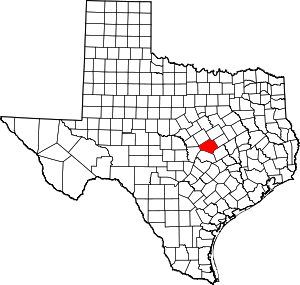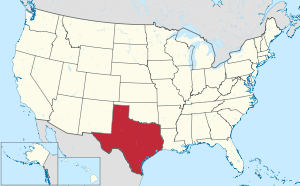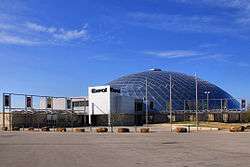Bell County, Texas
Bell County is a county located in the central part of the U.S. state of Texas. As of the 2010 census, its population was 310,235.[1] Its county seat is Belton.[2] The county was founded in 1850 and is named for Peter Hansborough Bell, the third governor of Texas.
Bell County | |
|---|---|
.jpg) The Bell County Courthouse in Belton | |
 Location within the U.S. state of Texas | |
 Texas's location within the U.S. | |
| Coordinates: 31°02′N 97°29′W | |
| Country | |
| State | |
| Founded | 1850 |
| Named for | Peter Hansborough Bell |
| Seat | Belton |
| Largest city | Killeen |
| Area | |
| • Total | 1,088 sq mi (2,820 km2) |
| • Land | 1,051 sq mi (2,720 km2) |
| • Water | 37 sq mi (100 km2) 3.4%% |
| Population (2010) | |
| • Total | 310,235 |
| • Density | 295/sq mi (114/km2) |
| Time zone | UTC−6 (Central) |
| • Summer (DST) | UTC−5 (CDT) |
| Congressional districts | 25th, 31st |
| Website | www |
Bell County is part of the Killeen–Temple, Texas, Metropolitan Statistical Area.
In 2010, the center of population of Texas was located in Bell County, near the town of Holland.[3]
History
In 1834–1835, Little River became part of Robertson's Colony, made up of settlers from Nashville, Tennessee, led by Sterling C. Robertson; they were the families of Captain Goldsby Childers, Robert Davison, John Fulcher, Moses Griffin, John Needham, Michael Reed and his son William Whitaker Reed, William Taylor, and Judge Orville T. Tyler.[4] This area became known as the Tennessee Valley. Soon after (1836) the settlements were deserted during the Runaway Scrape,[5] reoccupied, deserted again after the Elmwood Creek Blood Scrape, and reoccupied. Texas Ranger George Erath established a fort on Little River.[6]
During 1843–44, settlers began returning .[4] The next year, the Republic of Texas founded Baylor Female College (since developed as University of Mary Hardin–Baylor).[7]
In 1850, Bell County was organized and named for Texas Governor Peter Hansborough Bell. The population then was 600 whites and 60 black slaves.[4] Belton[8] was designated as the county seat in 1851.
The last serious Indian raid in the area occurred in 1859.[4] Bell County assumed its present boundaries[4] with the 1860 resurvey of the line between Bell and Milam Counties.
In 1861, the county voted for secession from the Union.[4] Residents were divided, as many yeomen farmers did not support the war. From 1862–1865, Union sympathizers and Confederate deserters holed up in "Camp Safety".[4] Following the war, new social movements developed. In 1867, the Belton Women’s Commonwealth, the first women’s movement in Central Texas, was formed by Martha McWhirter. The group provided shelter to women in abusive relationships.[4]
During the early years of the Reconstruction era (1865–1877), so much violence occurred in the county, the government stationed federal troops in Belton. Some racist whites attacked blacks and their white supporters. Corruption, lawlessness, and racial divides were severe. As in many areas, a local version of white paramilitary insurgents developed who were similar to the KKK; they worked to suppress black and Republican voting.[4]
The coming of railroads in the late 19th century stimulated growth across the state. In 1881, the Gulf, Colorado and Santa Fe Railway, the first railroad to be built in Bell County, established Temple as its headquarters.[4] Reflecting growth in the county, in 1884, the Bell County Courthouse was built. It is still used. The ambitious Renaissance Revival design was by architect Jasper N. Preston and Sons.[9] As another improvement, in 1905, the Belton and Temple Interurban electric railway was completed, providing service between the cities.[4]
During the 1920s, the Ku Klux Klan underwent a revival in Bell County. In many areas, it was concentrated on nativist issues, opposing Catholic and Jewish immigration from eastern and southern Europe. After a scandal involving the leader of the KKK, the group's influence declined markedly by the end of the decade.[4]
In 1925, Miriam A. Ferguson, a native of the county, was inaugurated as the first woman governor of the state.[10] She won re-election in 1932 for a nonconsecutive second term.[10]
The county and state supported founding Temple Junior College in 1926. The entry of the United States in World War II stimulated war spending across the country. In 1942, Fort Hood was opened as a military training base. It drew recruits from across the country.[4]
The postwar period was one of suburbanization in many areas. In 1956, the Killeen school board voted to integrate the local high school. This followed the Brown v. Board of Education (1954) ruling by the US Supreme Court that racial segregation in public schools, supported by all the taxpayers, was unconstitutional.[11]
The state founded Central Texas College in 1965 in Killeen.[11]
Since the late 20th century, new retail development has taken the form of large malls. In 1976, Temple Mall opened.[12] By 1980, Killeen had become the largest city in Bell County.[11] The next year, the Killeen Mall opened, adding to retail choices in the area.[13] In another type of development, in 1987, the Bell County Expo Center opened.
Since the late 20th century, the county has been the site of several mass shootings and unusual incidents of gun violence. On October 16, 1991, in what was called the Luby's shooting, disaffected employee George Jo Hennard, Jr., killed 23 people, and wounded 20 others, before killing himself. It was the largest mass murder by firearm in the United States to that time.[14] In 1995, Governor George W. Bush signed a new law easing restrictions on carrying handguns; it allows Texans to carry concealed weapons if they have a permit to do so. Texas overrode a 125-year-old ban on carrying weapons that had been signed and enacted by Governor E.J. Davis.[15] On November 5 in the 2009 Fort Hood shooting, Army Major Nidal Malik Hasan killed 13 people, and wounded 30. He was paralyzed in return fire. He had been described as mentally unstable. On April 2 in the 2014 Fort Hood shooting, Army Specialist Ivan Lopez killed three people and wounded 16.
Geography
According to the U.S. Census Bureau, the county has a total area of 1,088 square miles (2,820 km2), of which 1,051 square miles (2,720 km2) are land and 37 square miles (96 km2) (3.4%) are covered by water.[16]
Adjacent counties
- McLennan County (north)
- Falls County (northeast)
- Milam County (southeast)
- Williamson County (south)
- Burnet County (southwest)
- Lampasas County (west)
- Coryell County (northwest)
Demographics
| Historical population | |||
|---|---|---|---|
| Census | Pop. | %± | |
| 1860 | 4,799 | — | |
| 1870 | 9,771 | 103.6% | |
| 1880 | 20,518 | 110.0% | |
| 1890 | 33,377 | 62.7% | |
| 1900 | 45,535 | 36.4% | |
| 1910 | 49,186 | 8.0% | |
| 1920 | 46,412 | −5.6% | |
| 1930 | 50,030 | 7.8% | |
| 1940 | 44,863 | −10.3% | |
| 1950 | 73,824 | 64.6% | |
| 1960 | 94,097 | 27.5% | |
| 1970 | 124,483 | 32.3% | |
| 1980 | 157,889 | 26.8% | |
| 1990 | 191,088 | 21.0% | |
| 2000 | 237,974 | 24.5% | |
| 2010 | 310,235 | 30.4% | |
| Est. 2019 | 362,924 | [17] | 17.0% |
| U.S. Decennial Census[18] 1850–2010[19] 2010–2019[1] | |||
As of the census[20] of 2010, 310,235 people, 114,035 households, and 80,449 families resided in the county. The population density was 295.2 people per square mile (87/km2). The 125,470 housing units averaged 88 per square mile (34/km2). The racial makeup of the county was 61.4% White, 21.5% Black, 0.8% Native American, 2.8% Asian, 0.8% Pacific Islander, and 5.0% from two or more races. About 21.6% of the population was Hispanic or Latino of any race; 14.9% were of Mexican, 3.6% were of Puerto Rican, 0.2% Cuban, and 0.2% were of Dominican descent.
Of the 85,507 households, 40.10% had children under the age of 18 living with them, 56.60% were married couples living together, 12.30% had a female householder with no husband present, and 27.50% were not families. About 22.30% of all households were made up of individuals, and 6.50% had someone living alone who was 65 years of age or older. The average household size was 2.68 and the average family size was 3.14. As of the 2010 census, about 3.6 same-sex couples per 1,000 households were in the county.[21]
In the county, the population was distributed as 28.90% under the age of 18, 13.40% from 18 to 24, 31.90% from 25 to 44, 17.00% from 45 to 64, and 8.80% who were 65 years of age or older. The median age was 29 years. For every 100 females, there were 100.80 males. For every 100 females age 18 and over, there were 99.30 males.
The median income for a household in the county was $36,872, and for a family was $41,455. Males had a median income of $28,031 versus $22,364 for females. The per capita income for the county was $17,219. About 9.70% of families and 12.10% of the population were below the poverty line, including 16.30% of those under age 18 and 9.80% of those age 65 or over.
Education
Bell County is served by several school districts:
- Academy Independent School District
- Bartlett Independent School District (partial)
- Belton Independent School District
- Bruceville-Eddy Independent School District (partial)
- Copperas Cove Independent School District (partial)
- Florence Independent School District (partial)
- Gatesville Independent School District (partial)
- Holland Independent School District (partial)
- Killeen Independent School District (partial)
- Lampasas Independent School District (partial)
- Moody Independent School District (partial)
- Rogers Independent School District (partial)
- Rosebud-Lott Independent School District (partial)
- Temple Independent School District
- Troy Independent School District
- Salado Independent School District
Transportation
Major highways
These major highways run through Bell County:
.svg.png)

.svg.png)




Mass transit
The Hill Country Transit District operates a regularly scheduled fixed-route bus service within the urban areas of Killeen and Temple, as well as a paratransit service throughout the county.[22] Amtrak also has scheduled service to Temple.
Communities

Cities
- Bartlett (partly in Williamson County)
- Belton (county seat)
- Copperas Cove (mostly in Coryell County and a small part in Lampasas County)
- Harker Heights
- Killeen (largest city)
- Little River-Academy
- Morgan's Point Resort
- Nolanville
- Temple
- Troy
Village
Census-designated place
- Fort Hood (partly in Coryell County)
Unincorporated communities
Politics
| Year | Republican | Democratic | Third parties |
|---|---|---|---|
| 2016 | 54.3% 51,998 | 39.5% 37,801 | 6.2% 5,902 |
| 2012 | 57.4% 49,574 | 41.1% 35,512 | 1.6% 1,339 |
| 2008 | 54.4% 49,242 | 44.6% 40,413 | 1.0% 935 |
| 2004 | 65.4% 52,135 | 34.1% 27,165 | 0.5% 424 |
| 2000 | 65.1% 41,208 | 33.2% 21,011 | 1.7% 1,072 |
| 1996 | 53.2% 30,348 | 39.7% 22,638 | 7.1% 4,063 |
| 1992 | 45.3% 24,936 | 33.9% 18,684 | 20.8% 11,457 |
| 1988 | 61.8% 29,382 | 37.3% 17,751 | 0.9% 418 |
| 1984 | 69.5% 31,117 | 29.8% 13,322 | 0.7% 323 |
| 1980 | 54.7% 20,729 | 41.8% 15,823 | 3.5% 1,333 |
| 1976 | 46.0% 15,126 | 53.2% 17,499 | 0.9% 287 |
| 1972 | 71.8% 17,525 | 28.1% 6,848 | 0.2% 38 |
| 1968 | 27.0% 5,705 | 56.2% 11,893 | 16.8% 3,547 |
| 1964 | 16.8% 2,938 | 83.1% 14,557 | 0.1% 17 |
| 1960 | 30.1% 4,606 | 69.7% 10,651 | 0.2% 31 |
| 1956 | 30.8% 4,285 | 68.9% 9,603 | 0.3% 44 |
| 1952 | 33.9% 4,862 | 66.1% 9,484 | 0.1% 12 |
| 1948 | 11.7% 1,069 | 82.8% 7,548 | 5.4% 496 |
| 1944 | 8.5% 763 | 77.7% 6,960 | 13.8% 1,232 |
| 1940 | 12.4% 1,050 | 87.6% 7,418 | |
| 1936 | 7.2% 475 | 92.4% 6,119 | 0.4% 27 |
| 1932 | 8.7% 724 | 91.1% 7,607 | 0.3% 23 |
| 1928 | 52.2% 3,366 | 47.7% 3,079 | 0.1% 7 |
| 1924 | 17.3% 1,632 | 76.9% 7,273 | 5.8% 552 |
| 1920 | 7.9% 483 | 59.1% 3,595 | 32.9% 2,003 |
| 1916 | 8.5% 356 | 86.8% 3,615 | 4.7% 196 |
| 1912 | 4.0% 128 | 94.7% 3,024 | 1.3% 42 |
See also
- List of museums in Central Texas
- National Register of Historic Places listings in Bell County, Texas
- Recorded Texas Historic Landmarks in Bell County
- Hugh Shine, Republican member of the Texas House of Representatives from Bell County
References
- "State & County QuickFacts". United States Census Bureau. Archived from the original on July 7, 2011. Retrieved December 8, 2013.
- "Find a County". National Association of Counties. Archived from the original on 2012-07-12. Retrieved 2011-06-07.
- "Centers of Population by State: 2010". United States Census Bureau. Retrieved April 29, 2014.
- Connor, Seymour V; Odintz, Mark. "Bell County, Texas". Handbook of Texas Online. Texas State Historical Association. Archived from the original on 21 December 2010. Retrieved 30 November 2010.
- Covington, Carolyn Callaway. "Runaway Scrape". Handbook of Texas Online. Texas State Historical Association. Archived from the original on 12 November 2010. Retrieved 30 November 2010.
- Cutrer, Thomas W. "George Bernard Erath". Handbook of Texas Online. Texas State Historical Association. Retrieved 30 November 2010.
- Brackney, William H (2009). Congregation and Campus: Baptists in Higher Education. Mercer University Press. p. 147. ISBN 978-0-88146-130-5.
- "Belton, Texas". Texas Escapes. Texas Escapes - Blueprints For Travel, LLC. Retrieved 30 November 2010.
- "Bell County Courthouse". Texas Escapes. Texas Escapes - Blueprints For Travel, LLC. Retrieved 30 November 2010.
- Huddleston, John. "Miriam Ferguson". Handbook of Texas Online. Texas State Historical Association. Archived from the original on 21 December 2010. Retrieved 30 November 2010.
- Leffler, John. "Killeen, Texas". Handbook of Texas Online. Texas State Historical Association. Retrieved 30 November 2010.
- Urban Retail Properties: Temple Mall Archived March 17, 2013, at the Wayback Machine Center Information. Retrieved 31 December 2011.
- Jones Lang Lasalle (March 2010). "Killeen Mall" (PDF). Jones Lang Lasalle. Archived from the original (PDF) on 2016-03-04. Retrieved 2010-03-25.
- Woodbury, Richard (28 October 1991). "Crime: Ten Minutes in Hell". Retrieved 6 April 2018 – via www.time.com.
- , On the Issues
- "2010 Census Gazetteer Files". United States Census Bureau. August 22, 2012. Retrieved April 19, 2015.
- "Population and Housing Unit Estimates". United States Census Bureau. May 24, 2020. Retrieved May 27, 2020.
- "U.S. Decennial Census". United States Census Bureau. Retrieved April 19, 2015.
- "Texas Almanac: Population History of Counties from 1850–2010" (PDF). Texas Almanac. Retrieved April 19, 2015.
- "U.S. Census website". United States Census Bureau. Retrieved 2011-05-14.
- Where Same-Sex Couples Live, June 26, 2015, retrieved July 6, 2015
- "The Hop General Info". Hill Country Transit District. Retrieved 17 March 2014.
- Leip, David. "Dave Leip's Atlas of U.S. Presidential Elections". uselectionatlas.org. Retrieved 6 April 2018.
External links
| Wikimedia Commons has media related to Bell County, Texas. |
- Official website
- Bell County, Texas from the Handbook of Texas Online
- Bell County from the Texas Almanac
- Bell County from the TXGenWeb Project
- Bell County Ex Confederate Association Ledger, From 1888 To 1920.
- Historic Bell County materials, hosted by the Portal to Texas History.
